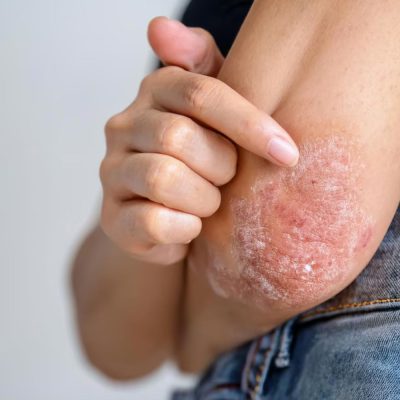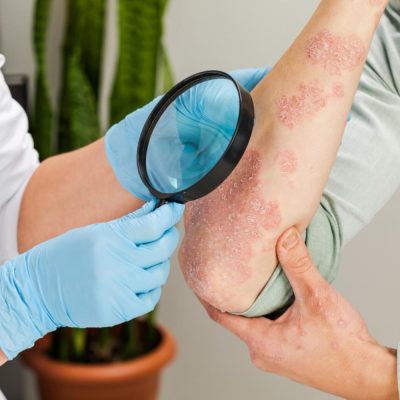Dermatitis
Dermatitis is a commonly used term for inflammation of the skin, resulting in redness, swelling and irritation. It is a very common condition that affects people of all ages. It can present in various forms, including eczema, contact dermatitis and seborrheic dermatitis. At SkinAccess Clinics, we offer comprehensive care for dermatitis, helping you achieve healthier and more comfortable skin.

What is Dermatitis?
Dermatitis is the inflammation of the skin that can cause a range of symptoms, from mild irritation to severe discomfort. Dermatitis is a broad term encompassing several different types of skin conditions, each with its causes and characteristics.
The most common forms of dermatitis are:
Atopic Dermatitis or Eczema
It is a chronic condition characterized by dry, itchy skin and rashes; often associated with allergies and asthma.
Contact Dermatitis
Localized skin reactions caused by exposure to irritants or allergens.
Seborrheic Dermatitis
Characterized by red, flaky skin, it commonly affects areas with high oil production like the scalp and face.
Symptoms of Dermatitis
Symptoms of dermatitis vary depending on the type and severity of the condition. Some common symptoms include
Redness
Inflammation causes the affected areas to become red and swollen.
Itching
Intense itching is a common symptom, often leading to scratching and worsening of the condition.
Dryness
Particularly in chronic cases, the skin may become dry, scaly or rough.
Rashes
Rashes may appear as patches of inflamed skin, blisters or oozing sores.
Swelling
The skin may have a puffy appearance due to swelling caused by inflammation.
Flakiness
Particularly in seborrheic dermatitis, flaking or peeling of the skin may be present.
Causes of Dermatitis
Depending on the type of dermatitis, it can be caused by a variety of factors.
The exact cause is yet unknown, but it is believed to be caused due to genetic and environmental factors. A weakened skin barrier and an overactive immune response could also contribute to this condition.
Caused by direct contact with irritants (soaps, detergents, etc.) or allergens (perfumes, plants, etc.).
This is thought to be caused by an overgrowth of the Malassezia yeast that thrives on the skin’s oils. Stress, hormonal changes and some medications may exacerbate the condition.

Diagnosis of Dermatitis
Diagnosing dermatitis involves a thorough evaluation by a dermatologist. The evaluation helps to determine the type of dermatitis and may include the following
Physical Examination
The appearance, location and distribution of the rash or irritation is assessed.
Medical History
The patient history review is conducted to assess any history of allergies, exposure to potential irritants or allergens and other relevant factors.
Patch Testing
This is particularly important for the diagnosis of contact dermatitis. It helps to identify specific allergens causing the reaction.
Skin Biopsy
At times, a skin biopsy may be required to confirm the diagnosis and rule out other skin conditions.
Management and Treatment of Dermatitis
The type and severity of the condition determine the effective management and treatment plan provided. At SkinAccess Clinics, we offer a range of tailored care plans designed to alleviate symptoms and prevent flare-ups.
➥ Topical Treatments:
- Steroid Creams: It helps reduce inflammation and itching. Various strengths are available and are prescribed based on the severity of the condition.
- Non-Steroidal Creams: They can be used for sensitive areas or long-term management without the side effects of steroids.
➥ Moisturizers & Emollients: Regular use helps to restore the skin barrier, reduce dryness and alleviate itching.
➥ Identification & Avoidance of Triggers: Particularly in the case of contact dermatitis, it is important to identify and avoid irritants or allergens. This may also involve the use of hypoallergenic products and wearing protective clothing.
➥ Stress Management: Learning relaxation techniques to manage stress can help reduce flare-ups of atopic dermatitis and seborrheic dermatitis.
➥ Skincare Routine: The use of gentle, fragrance-free products and avoiding hot water can help minimize irritation.
➥ Medications:
- Oral Antihistamines: They help manage severe itching and allergic reactions.
- Oral Steroids: A short course of steroids may be prescribed for severe and widespread cases.
➥ Phototherapy (Light Therapy): Controlled exposure to ultraviolet (UV) light can help reduce inflammation and improve symptoms in chronic cases.
